Yamaha PLG150PFE, PLG150-PF User Manual
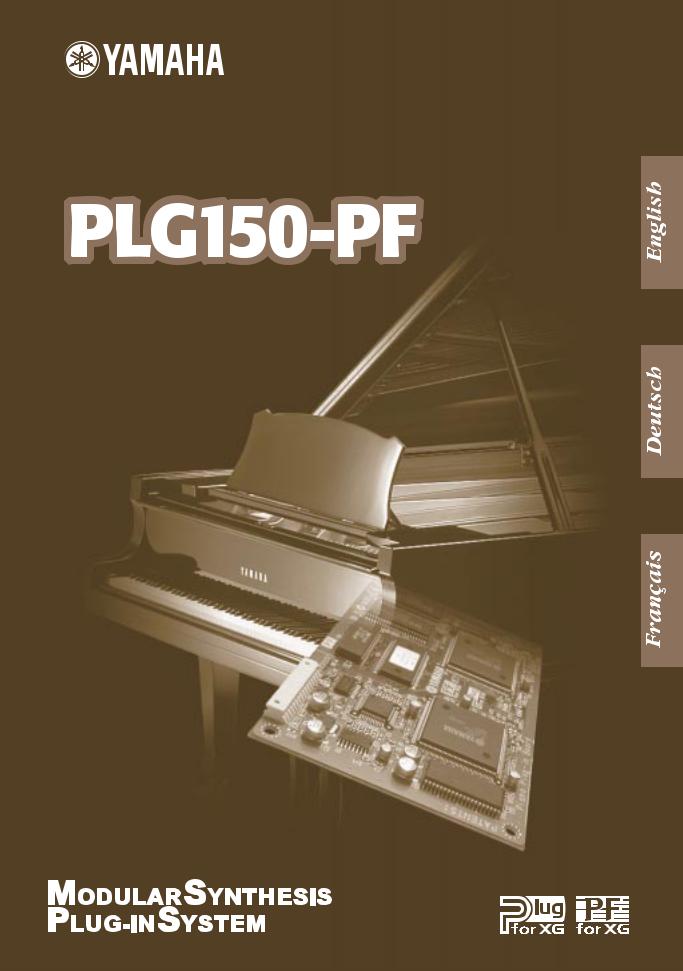
Piano Plug-in Board Piano Plug-in Board Carte Plug-in piano
Owner’s Manual Bedienungsanleitung Mode d’emploi

Precautions
●Do not expose the plug-in board to direct sunlight, excessive humidity, high temperatures, excessive dust or strong vibrations.
●Before handling the plug-in board, be sure to touch a metal surface to discharge any static electricity which may be in your body.
●When holding the plug-in board, do not touch the inside area of the circuit board or apply excessive pressure to the board, and be sure to protect the board from contact with water or other liquids.
●Before installing the plug-in board onto a tone generator/sound card, unplug the power connector of your computer.
●Before connecting the computer to other devices, turn off the power switches of all devices.
●Yamaha is not responsible for loss of data through computer malfunctions or operator actions.
●The plug-in board contains no user-serviceable parts, so never touch the inside area of the circuit board or tamper with the electronic circuitry in any way. Doing so may result in electrical shock or damage to the plugin board.
YAMAHA CANNOT BE HELD RESPONSIBLE FOR DAMAGE CAUSED BY IMPROPER CARE AND USE OF THE PLUG-IN BOARD.
*The company names and product names in this Owner’s Manual are the trademarks or registered trademarks of their respective companies.
*The screens as illustrated in this owner’s manual are for instructional purposes only, and may appear somewhat different from the ones of your instrument.
FCC INFORMATION (U.S.A.)
1.IMPORTANT NOTICE: DO NOT MODIFY THIS UNIT!
This product, when installed as indicated in the instructions contained in this manual, meets FCC requirements. Modifications not expressly approved by Yamaha may void your authority, granted by the FCC, to use the product.
2.IMPORTANT: When connecting this product to accessories and/or another product use only high quality shielded cables. Cable/s supplied with this product MUST be used. Follow all installation instructions. Failure to follow instructions could void your FCC authorization to use this product in the USA.
3.NOTE: This product has been tested and found to comply with the requirements listed in FCC Regulations, Part 15 for Class ”B” digital devices. Compliance with these requirements provides a reasonable level of assurance that your use of this product in a residential environment will not result in harmful interference with other electronic devices. This equipment generates/uses radio frequencies and, if not installed and used according to the instructions found in the users manual, may cause interference harmful to the operation of other electronic devices. Compliance with FCC regulations does not guarantee that interference will not occur in all installations. If this product is found to be the source of interference, which can be determined by turning the unit ”OFF” and ”ON”, please try to eliminate the problem by using one of the following measures:
Relocate either this product or the device that is being affected by the interference.
Utilize power outlets that are on different branch (circuit breaker or fuse) circuits or install AC line filter/s.
In the case of radio or TV interference, relocate/reorient the antenna. If the antenna lead-in is 300 ohm ribbon lead, change the lead-in to co-axial type cable.
If these corrective measures do not produce satisfactory results, please contact the local retailer authorized to distribute this type of product. If you can not locate the appropriate, please contact Yamaha Corporation of America, Electronic Service Division, 6600 Orangethorpe Ave, Buena Park, CA 90620
* This applies only to products distributed by YAMAHA CORPORATION OF AMERICA.
CANADA
This Class B digital apparatus complies with Canadian ICES-003.
Cet appareil numérique de la classe B est conforme à la norme NMB-003 du Canada.
•This applies only to products distributed by Yamaha Canada Music Ltd.
•Ceci ne s’applique qu’aux produits distribués par Yamaha Canada Musique Ltée.
2

Congratulations and thank you for purchasing the Yamaha PLG150-PF Piano Plug-in Board!
The PLG150-PF is a custom tone generator designed for use with a variety of Yamaha electronic musical instruments. Foremost, the PLG150-PF can be installed to and integrated with instruments of the Modular Synthesis Plug-in System (such as the CS6x, CS6R, S80, etc.) It can also be used seamlessly with the MU128 Tone Generator (as well as other MU-series instruments and the SW1000XG PCI Audio/MIDI Board). The PLG150-PF provides a wide variety of exceptionally high-quality, authentic keyboard instrument sounds — including piano, electric piano, harpsichord, clav, and others. It features its own built-in EQ, Reverb, Chorus, and Insertion effects, allowing you to process the sound without having to use the effects resources of the “mother” device.
The settings and parameters of the PLG150-PF can also be conveniently edited with a Windows PC computer by using the PF Easy Editor software module (included in the XGworks Music Sequencer software).
Table of Contents
Overview of the PLG150-PF ..................................... |
4 |
Parameter Structure ............................................... |
6 |
Specifications ............................................................. |
7 |
About the Included Floppy Disks.............................. |
8 |
Installing the PLG150-PF ........................................... |
9 |
Included Items............................................................. |
9 |
Required and Recommended Items ...................... |
10 |
Synthesizer/Tone Generator/ |
|
Sound Card Compatible with the Modular |
|
Synthesis or XG Plug-in Systems.................. |
10 |
XGworks or XGworks lite |
|
Music Sequencing Software .......................... |
10 |
PF Easy Editor ................................................... |
10 |
Installing and Starting the Plug-in |
|
Editor Software (Windows 95/98) ................... |
11 |
Installing the Software ........................................ |
11 |
Starting the PF Easy Editor ................................ |
11 |
Selecting PF Voices |
|
(Modular Synthesis Plug-in System)................ |
12 |
Enabling and Selecting PF Voices ..................... |
12 |
Editing the PF Native Part Parameters |
|
(Modular Synthesis Plug-in System) ................ |
13 |
Selecting/Editing the PF System Parameters |
|
(Modular Synthesis Plug-in System) ................ |
14 |
Selecting PF Voices (XG Plug-in System)............. |
15 |
Enabling and Selecting PF Voices ..................... |
15 |
Editing the PF Native Part Parameters |
|
(XG Plug-in System).............................................. |
17 |
Selecting/Editing the PF System Parameters |
|
(XG Plug-in System).............................................. |
18 |
Parameters ............................................................... |
19 |
PF Native Part Parameters................................. |
19 |
PF System Parameters ...................................... |
23 |
Appendix..................................................................... |
24 |
Voice List................................................................ |
24 |
PLG150-PF Voice Effect Parameter List........... |
30 |
Effect Data Assign Table ..................................... |
33 |
Parameter List (XG / Modular |
|
Sysnthesis Plug-in System) ............................ |
34 |
MIDI Data Format .................................................. |
35 |
MIDI Implementation Chart ................................. |
42 |
3
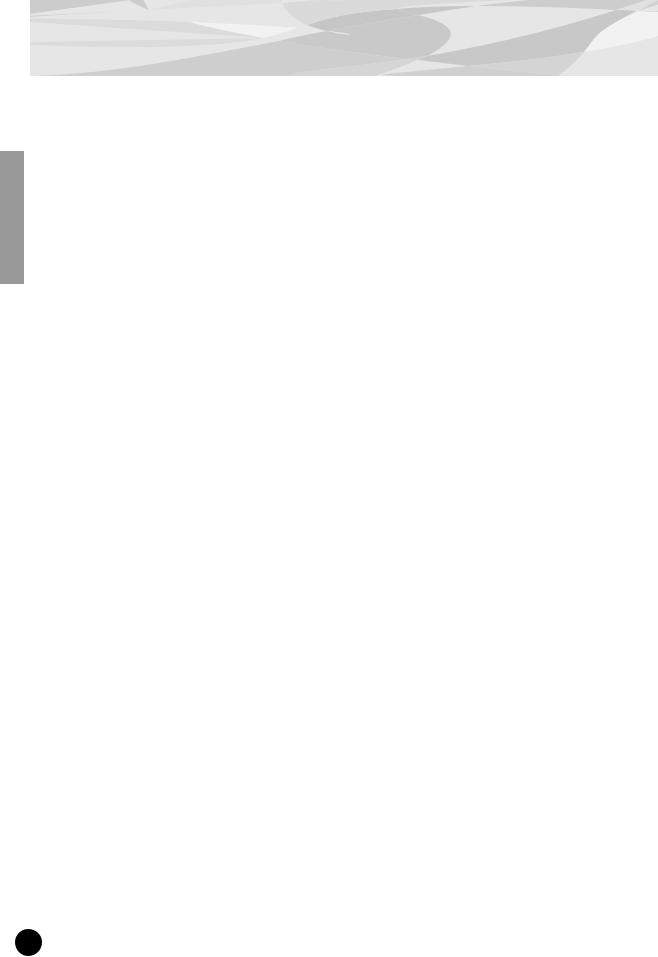
Overview of the PLG150-PF
The PLG150-PF is a sophisticated tone generator board that provides realistic piano and other keyboard sounds. Utilizing Yamaha’s state-of-the-art AWM2 tone generation system along with true stereo sampling, the PLG150-PF features exceptionally rich, natural and authentic instrument voices, to augment the sound palette on the “mother” device.
■ Easy Installation
Once it is connected, the PLG150-PF automatically becomes another sound source in the tone generator/sound card, and can be used as one of the instrument Parts. You can create your own original PF voices and combine PF voices with the other voices in the “mother” device.
■ 136 Voices and 64-note Polyphony
The PLG150-PF is packed with a total of 132 rich and authentic keyboard voices. Many of the acoustic grand piano sounds have been recorded in stereo for enhanced realism and luxurious tone. The PLG150-PF also has a huge variety of realistic electric piano voices, covering a broad stylistic range
— from the classic keyboards of the ‘60s and ‘70s, to the crisp and bright digital sounds of recent years. In addition to the electric grand, harpsichord and clav voices, a variety of combination voices are also included, letting you play sustained pad and choir sounds, layered with piano. A maximum 64-note polyphony lets you play complex sustained chords and passages, without worrying about notes being cut off. (For certain stereo and combination voices, the polyphony may be 32 notes or less.)
■ Built-in Effects
The PLG150-PF also has its own dedicated effects processing. This means that you can apply EQ, Reverb, Chorus, and even a Insertion effect to the voice, letting you use all of the effects on the “mother” device for the other Parts.ong.
4
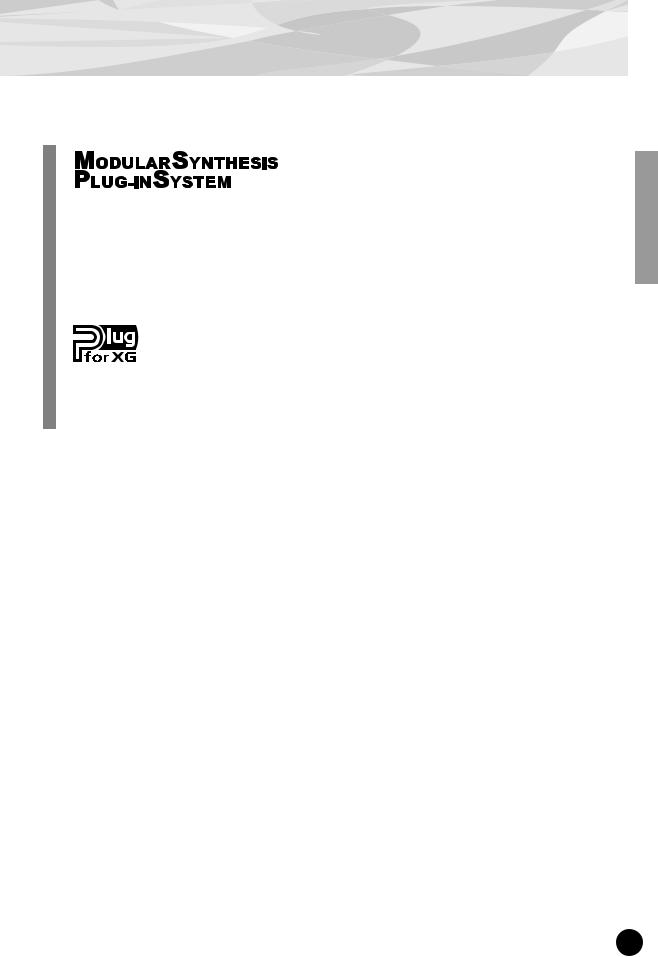
Overview of the PLG150-PF
About the Modular Synthesis Plug-in System
The Yamaha Modular Synthesis Plug-in System offers powerful expansion and upgrade capabilities for Modular Synthesis-Plug-in-compatible synthesizers, tone generators and sound cards. This enables you to easily and effectively take advantage of the latest and most sophisticated synthesizer and effects technology, allowing you to keep pace with the rapid and multifaceted advances in modern music production.
About the XG Plug-in System
The Yamaha XG Plug-in System offers powerful expansion and upgrade capabilities for XG- Plug-in-compatible tone generators and sound cards. This enables you to easily and effectively take advantage of the latest and most sophisticated synthesizer and effects technology, allowing you to keep pace with the rapid and multi-faceted advances in modern music production.
5

Parameter Structure
Plug-in Board |
|
Plug-in Platform |
System Parameter |
|
XG Effect Parameter |
XG System Parameter |
Reverb |
|
PF Native System Parameter |
Chorus |
|
|
|
Variation |
Part Parameter |
|
Insertion1 |
XG Part Parameter |
|
Insertion2 |
Part Parameter |
|
|
Part Parameter |
|
|
PF Native Part Parameter |
|
|
XG Part Parameter |
|
|
XG Part Parameter |
|
|
Part Parameter |
|
|
PF Native Part Parameter |
|
|
PF Native Part Parameter |
|
|
XG Part Parameter |
|
|
PF Native Part Parameter |
|
|
|
Offset |
|
PF Voice Parameter |
|
|
Element4 |
|
|
Element3 |
|
|
Element2 |
|
|
Element1 |
|
|
Voice |
Voice |
|
Reverb |
Chorus |
|
Voice |
Voice |
|
Insertion |
EQ |
|
The Plug-in voices are made here.
6

Specifications
TONE GENERATOR/MODULES : |
AWM2 |
|
|
POLYPHONY : |
64 notes maximum (latest note priority; polyphony is expandable *1) |
|
|
|
|
*1 On the CS6x, for example, two boards can be installed for a |
|
|
|
maximum of 128 notes; on the MU128, three boards can be |
|
|
|
|
|
|
|
installed for a maximum of 192 notes. |
|
NUMBER OF VOICES : |
136 |
XG voices (PF-XG/A, PF-XG/B) |
|
|
128 |
Preset voices |
|
INTERFACE : |
Plug-in connector |
|
|
EFFECTOR : |
Reverb, Chorus, Insertion, 2-Band EQ |
|
|
DIMENSIONS (W x H x D) : |
138.5 x 89.0 x 8.5mm |
|
|
WEIGHT : |
72g |
|
|
INCLUDED ITEMS : |
Owner’s Manual, Floppy disk |
|
|
* Specifications subject to change without notice.
7

About the Included Floppy Disk
The included floppy disk contain editing software for the PLG150-PF as well as demonstration songs and Voice data for the “mother” device.
To use the editing software and transfer the song/Voice data to your particular “mother” device, you should have a computer (running Windows 95/98) with a MIDI interface, with the MIDI OUT on the interface connected to the MIDI IN of the “mother” device. You should also have XGworks (v3.0 or higher) or XGworks lite installed to your computer; this is necessary to use the editing software (page 10). For playing back the demonstration songs and transferring the Voice data, you can use any compatible sequence software (such as XGworks/XGworks lite) or hardware sequencer capable of sending bulk data. Insert the disk into the computer and start the installation.
The following software is included on the disk:
■PF Easy Editor (page 10)
■Demonstration Songs
(1) “Fantaisie-impromptu op.66” (02Fanta.mid)
By: Frederic Chopin
For: Modular Synthesis Plug-in System devices (CS6x, etc.) and XG Plug-in System devices (MU128, etc.)
(2) “THE PF THEATRE” (02Theatr.mid)
By: Katsunori Ujiie (Idecs, Inc.)
For: XG Plug-in System devices (MU128, etc.)
(3) “SOLO-demo” (02Solo.mid)
By: Katsunori Ujiie (Idecs, Inc.)
For: Modular Synthesis Plug-in System devices (CS6x, etc.) and XG Plug-in System devices (MU128, etc.)
■Plug-in Voice Data for CS6x/CS6R/S80 (Modular Synthesis Plug-in System)
This is Plug-in voice data, featuring a total of 64 voices that were created using the PLG150-PF Preset voices. When the PLG150-PF is installed to PLG1, select the file “01PlgVc1.mid”; when the board is installed to PLG2, select the file “01PlgVc2.mid.”
For a complete list of these voices, refer to the Plug-in Voice List (page 29).
8

Installing the PLG150-PF
For detailed instructions on installing the PLG150-PF, refer to the owner’s manual of the Plug-in- compatible “mother” device (e.g., CS6x, MU128, etc.).
Included Items
The following items have been included in the package of your new PLG150-PF. Please make sure that you have them all before starting to setup and use the instrument. If an item is missing, contact the store or dealer from which you purchased the PLG150-PF.
•PLG150-PF board
•PLG150-PF Owner’s Manual (this book)
•Floppy disk
9

Required and Recommended Items
In addition to the included items listed above, you should also have the following:
Synthesizer/Tone Generator/Sound Card Compatible with the Modular Synthesis or XG Plug-in Systems
In order to use the PLG150-PF, you’ll need a synthesizer, tone generator or sound card compatible with the Modular Synthesis Plug-in System or the XG Plug-in System. Compatible instruments include the CS6x, MU128, and the SW1000XG. The synthesizer/tone generator/sound card should al so have an available slot or space for installing the PLG150-PF.
XGworks or XGworks lite Music Sequencing Software
These software sequencers provide convenient tools for taking full advantage of the PLG150-PF, letting you create song data that automatically selects and plays back the PF voices. They also include the powerful PF Easy Editor (see below) for editing and controlling the PF voices. XGworks lite is contained on a CD-ROM included with the CS6x, MU128, etc., and XGworks is contained on a CDROM included with the SW1000XG.
PF Easy Editor
The PF Easy Editor is a special plug-in software module for XGworks and XGworks lite. It provides convenient easy-to-use control over the most important PLG150-PF settings and parameters. It also provides exceptionally intuitive editing, with a virtual “front panel” display that lets you change the settings with sliders.
Using the PF Easy Editor is just like using the Part editing controls on your tone generator — it indirectly and temporarily changes the PF voices without making changes to the original voice. The changed parameters can either be inserted into a song to automate sound changes, or can be saved as an PF parameter file for future recall. The PF Easy Editor software is contained on the included floppy disk.
10
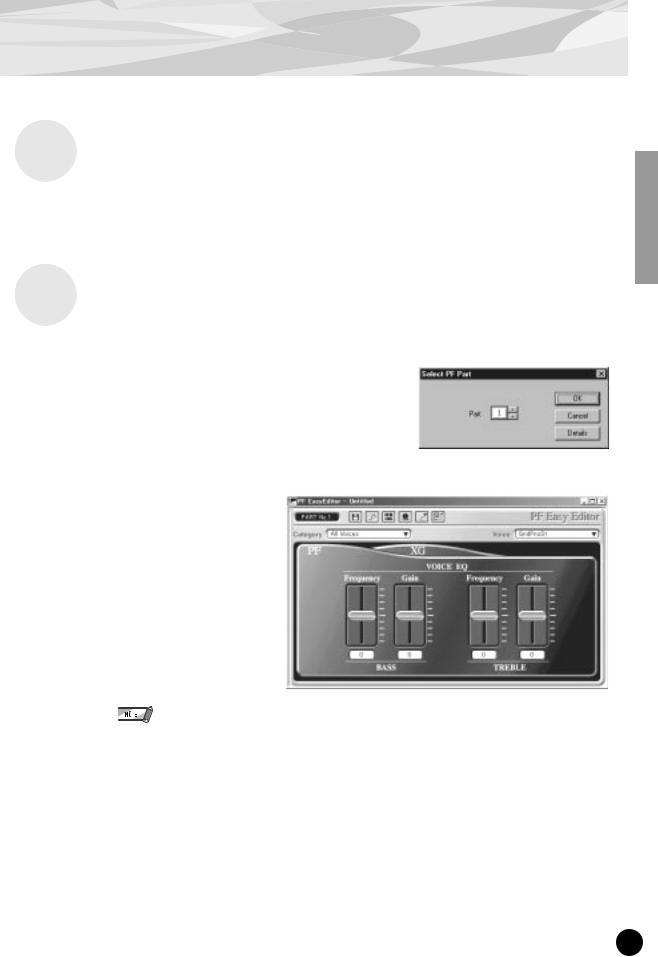
Installing and Starting the Plug-in Editor Software (Windows 95/98) 

Installing the Software
Double-click the “Setup.exe” file in the “Plug_” folder on the floppy disk to start the installation. Click “Next” or “Yes” and follow the subsequent instructions on the screen to complete the installation.
Starting the PF Easy Editor
1 Start XGworks (or XGworks lite).
2 Click the “Plug-in” menu and select “PF
Easy Editor.”
Alternately, press Alt + P, then D, and ENTER. The
“Select PF Part” dialog box appears.
3 Set the desired Part number and click “OK.”
The PF Easy Editor window appears.
If the PLG150-PF has been properly installed and all computer/ MIDI connections have been properly made, operating the PF Easy Editor should directly affect the PLG150-PF. For details on using the PF Easy Editor, refer to the on-line help file that is included with the software.
When using a Modular Synthesis Plug-in System “mother” device, the Part assignment depends on which mode is used — Voice or Performance — and also on whether the PLG150-PF board is installed/assigned to PLG1 or PLG2, as described below.
When using the Voice mode:
Depending on which slot the PLG150-PF board has been installed to, press PLG1 or PLG2, then set the Part to “1” (no matter what the PLG1 or PLG2 assignment is).
When using the Performance (Multi) mode:
If the PLG150-PF board is assigned to PLG1, set the Part to “16.”
If the PLG150-PF board is assigned to PLG2, set the Part to “15.”
11

Selecting PF Voices
(Modular Synthesis Plug-in System) 
When the PLG150-PF is installed to a CS6x Control Synthesizer, the PF voices can be selected in
the same way as the internal voices of the synthesizer.
The example displays used in the following explanations are all taken from the CS6x.
Enabling and Selecting PF Voices
1 Press the VOICE button.
2 Press the appropriate PLG button (PLG1 or PLG2, depending on which slot the PLG150-PF board has been installed to), then press the appropriate BANK button and PROGRAM button to select the desired Plug-in voice.
 VCE Play) PLG1:001(A01)[PF:GndPnoSt ]
VCE Play) PLG1:001(A01)[PF:GndPnoSt ]
EQLow-G EQMid-G EQHi-G ------- -------
To select a different bank, simultaneously hold down the appropriate PLG button and turn knob C (or press the DEC/INC buttons) to select the desired bank.
The bank is expressed in two numbers: MSB and LSB.
 VCE Play) PLG1:001(A01)[PF:GndPnoSt ]
VCE Play) PLG1:001(A01)[PF:GndPnoSt ]
BANK= 080/000
If a selected bank is not available, the bank letter indication in the display (A - H) will not change. For a list of the available banks and their MSB/LSB values, refer to the “PF-XG Voice Map” at the back of this manual (pages 26 — 28).
12

Editing the PF Native Part Parameters
(Modular Synthesis Plug-in System) 
● Keep in mind that the parameter values and settings below represent offsets of the actual voice settings. This means that adjustments made to the parameters may not make much change in the actual sound, depending on the original settings of the voice. For parameter values, a setting of “0” results in no change, while positive and negative values increase and decrease the value respectively.
●The following explanations show how to edit the PF native part parameters when creating PLG voices, using the CS6x Control Synthesizer as an example. For information on storing the PLG voices with your particular Modular Synthesis Plug-in System compatible instrument, refer to the owner’s manual of that instrument.
1Select the desired PF voice, as described in “Selecting PF Voices” on page 12.
2Press the EDIT button.
The EDIT menu display appears.
|
|
|
|
GEN Name) Pf-Sq |
a-Z |
0-? Cursor |
|
Commom |
|
[PF:GndPnoSt ] |
|
|
|
|
|
3 Turn knob A clockwise until “Elem” is shown at the bottom left of the display.
PLG Assign) |
Bank |
Number |
Elem |
080/000 |
1[GndPnoSt] |
|
|
|
4 Turn the PAGE knob clockwise until “PLG150-PF” is shown at the bottom left of the display.
Keep turning the knob to select the different PF Part parameters, indicated just above knob C and
knob 2.
NTV Param) |
PF Mode |
SusCurve |
PLG150-PF |
ON |
Normal |
|
|
|
5 Use knobs C and 2 to select the desired parameter and change the value.
Once one of the parameters is selected (the arrow cursor appears next to the value), you can also
adjust the value with the DATA knob or the DEC/INC buttons.
13

Selecting/Editing the PF System Parameters
(Modular Synthesis Plug-in System) 
The example displays used in the following explanations are all taken from the CS6x.
1 Press the UTILITY button.
The Utility Mode display appears.
|
|
|
|
|
|
MSTR TG) |
Vol |
NtShift |
|
Tune |
|
Sys |
64 |
+ 0 |
+ |
0.0c |
|
|
|
|
|
|
|
2 Turn the PAGE knob clockwise until “PLG150-PF” is shown at the bottom left of the display.
Keep turning the knob to select the different PF System parameters, indicated just above knob C
and knob 2.
|
|
|
|
PLG1 MIDI) |
PartAssign |
VelCurve |
|
PLG150-PF |
01 |
Normal |
|
|
|
|
|
3 Use knobs C and 2 to select the desired PF System parameter and change the value.
Once one of the parameters is selected (the arrow cursor appears next to the value), you can also
adjust the value with the DATA knob or the DEC/INC buttons.
14
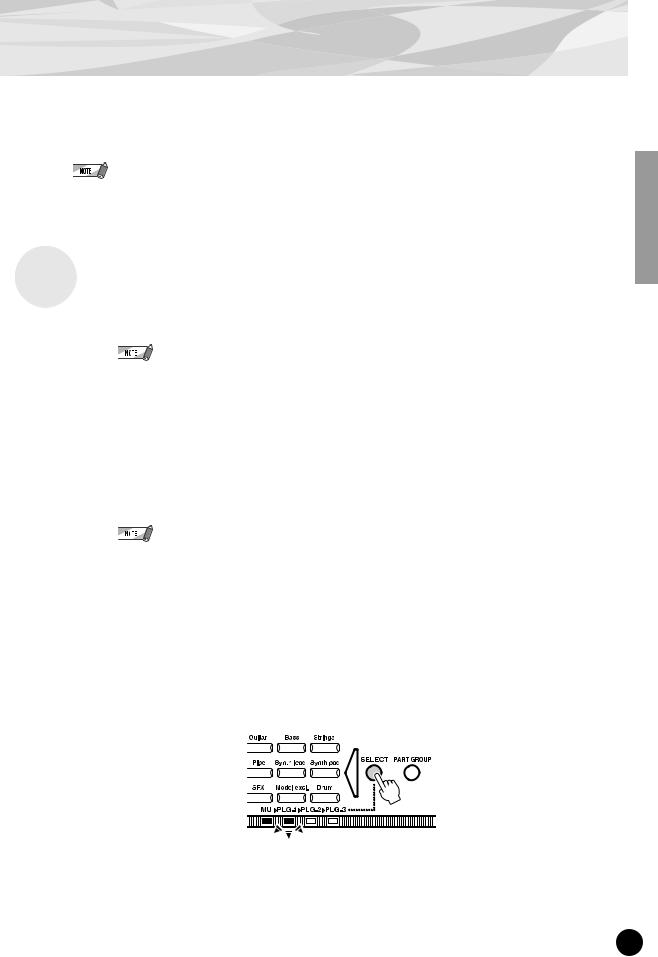
Selecting PF Voices (XG Plug-in System)
The PLG150-PF voices can be selected just like the voices of the XG tone generator. Keep in mind, though, that they can only be selected when the Sound Module Mode is set to XG or Performance. Also, the Part Assign parameter in the Utility mode (see below) must be set to the desired Part.
The example displays used in the following explanations are all taken from the MU128.
Enabling and Selecting PF Voices
1 Set the Sound Module Mode to “XG” or “PFM” (Performance).
Press the MODE button and use the SELECT </> buttons.
The Performance mode is not available on the SW1000XG.
2 Set the Part Assign parameter to the desired Part number.
To do this:
1)Press the UTIL button.
2)Select the “PLUGIN” menu (with the SELECT> button) and press ENTER.
3)Select the “PLG150-PF” menu if necessary (with the SELECT</> buttons), and press ENTER.
4)Select the Part Assign parameter (with the SELECT < button), and use the VALUE -/+ buttons or dial to change the Part number.
The Part Assign range for the XG mode is 1 - 16 and “off”; for the Performance mode, it is 1 - 4 and “off.”
Press the EXIT button to return to the Play mode.
This operation can also be quickly and conveniently done from the PF Easy Editor (in XGworks).
3 Enable the PLG150-PF board for the desired Part.
First, make sure that the appropriate Part is selected (using the PART -/+ buttons), then press the SELECT button. The icon of the selected board appears in the display and the corresponding LED at the bottom of the panel (PLG-1, -2, or -3) flashes briefly.
15
